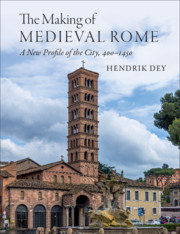Book contents
- The Making of Medieval Rome
- The Making of Medieval Rome
- Copyright page
- Contents
- Preface
- Introduction
- Chapter 1 The Eternal City on the Brink
- Chapter 2 401–552
- Chapter 3 552–705
- Chapter 4 705–882
- Chapter 5 The Long Twilight of the Early Middle Ages
- Chapter 6 1046–1230
- Chapter 7 1230–1420
- Epilogue
- Notes
- References
- Index
Epilogue
Rome and Pope Nicholas V (1447–55)
Published online by Cambridge University Press: 30 September 2021
- The Making of Medieval Rome
- The Making of Medieval Rome
- Copyright page
- Contents
- Preface
- Introduction
- Chapter 1 The Eternal City on the Brink
- Chapter 2 401–552
- Chapter 3 552–705
- Chapter 4 705–882
- Chapter 5 The Long Twilight of the Early Middle Ages
- Chapter 6 1046–1230
- Chapter 7 1230–1420
- Epilogue
- Notes
- References
- Index
Summary
In december 1450, as the festive and very successful Jubilee year was drawing to a close, tragedy famously struck at Ponte Sant’Angelo. It was evening, and thousands of pilgrims were coming back from the Borgo to their lodgings across the river. As the flow of pedestrians on the congested roadway over the bridge slowed and stopped, those behind continued to push ahead; in the resulting squeeze, the parapets of the bridge gave way and some 200 people died, either crushed above or drowned in the waters below. Pope Nicholas V Parentucelli reacted decisively in the wake of the disaster. He expropriated the shops and stalls that packed the approaches to the bridge on the Campus Martius side (using some of the piles of cash collected during the Jubilee to compensate the proprietors), and leveled them to create an open esplanade hundreds of meters long and dozens of meters wide, with the road running through the center. Around the periphery of this sort of grand boulevard, the Canale di Ponte, rose regular rows of new shops for the bankers and merchants who crowded into this strategic crossing-point between the Borgo and the city-center.
- Type
- Chapter
- Information
- The Making of Medieval RomeA New Profile of the City, 400 – 1420, pp. 255 - 261Publisher: Cambridge University PressPrint publication year: 2021



